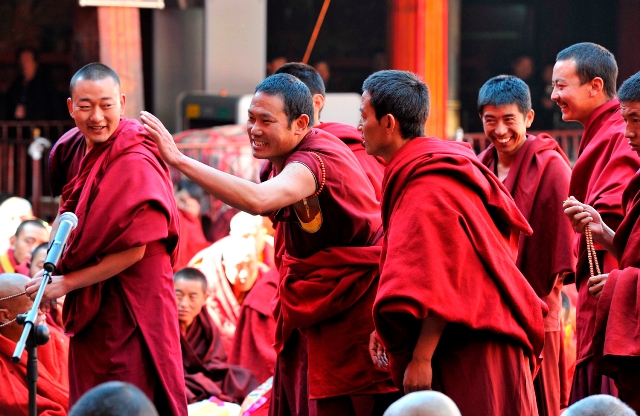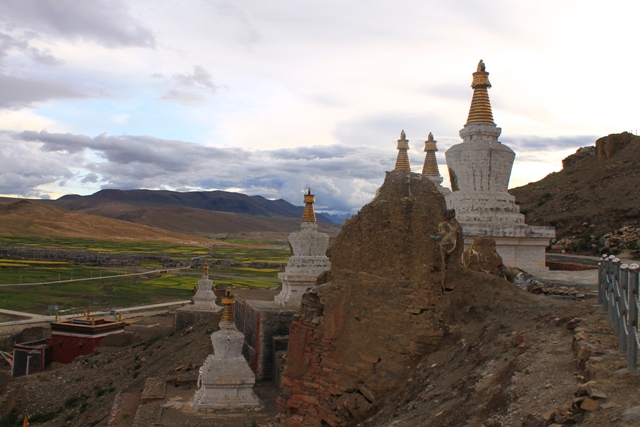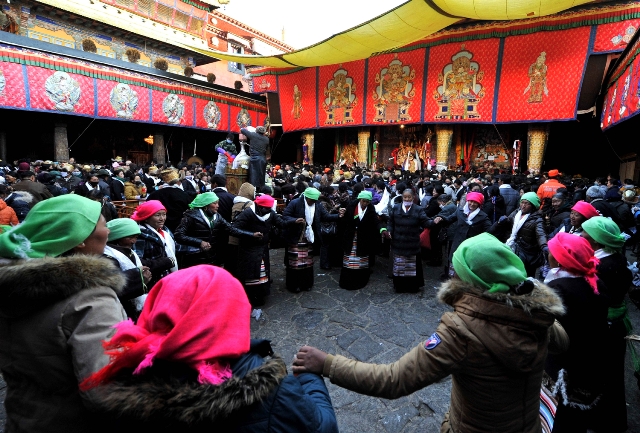![]() : submit your enquiry or send email to us (you can easily find many suggested itineraries on the first page of our website).
: submit your enquiry or send email to us (you can easily find many suggested itineraries on the first page of our website).

![]() : Receive a quotation.
: Receive a quotation.

![]() : Free trip suggestion from our professional tour consultant.
: Free trip suggestion from our professional tour consultant.

![]() : Pay 25% for confirmation.
: Pay 25% for confirmation.

![]() : Get invoice from us.
: Get invoice from us.
 Sonam tsering (indigenous guide)
Sonam tsering (indigenous guide)I was born and grew up in Lhasa. For last six years experiences of been a tour guide, I came to realised that education counts, especially being a Tibetan……
 Nyima (local tour guide)
Nyima (local tour guide)Nyima was born in a nomadic family in eastern part of Tibet. Nyima has been a tour guide for more than 8 years and he had travelled every corner in……
 Sonam(local tour guide)
Sonam(local tour guide)HSonam was born in a small village in Lunchup County which is near by Lhasa. He studied 5 years in Tong Khar Language School in Lhasa, and got average 70 percent……
 Pasang (local tour guide)
Pasang (local tour guide)Pasang was born in Lhasa, and she is reliable, highly motivated person with a light-hearted manner. She studied English in a language school in mainland for four years and got English guide license several years ago……
Review from Lovella (Canadian)
Name of the Tour:Ancient City to Namtso Tour
Thank you very much for arranging Penpa as our guide. He has been extremely helpful and has made our stay here in Tibet a most memorable and wonderful experience. Penpa is very kind, honest and well informed.
Date:15-08-14
Review from Frances& Erin (American)
Name of the Tour:Exploration of Mountain Everest and Namtso Lake Tour
Review: Our tour guide is honest and reliable, he can do magic tricks,sing,play guitar and take beautiful pictures. So he is multi-talented :)
Date:6-08-14
Review from May (British)
Name of the Tour:Exploration of Mountain Everest and Namtso Lake Tour
Dear Saturday,
Thank you very much for all of your efforts. We really appreciate it. All the best.
Date:22-06-14
Review from Bill (Canadian)
Name of the Tour:Exploration of Mountain Everest and Namtso Lake Tour
Dear Saturday,
Because of your wonderful tour we were able to have a great time in Tibet,we learned more things and have wonderful memories. Thank you so much for your friendly and amazing work. We love Tibet!
Date:11-07-12
Review from Marc Bourgeois (French)
Name of the Tour: Holy City to Yamdrok Lake Tour
The guide was awesome,he make the temple and monastery more interesting,he was nice with us! Thank you Penpa!
Date:15-08-14
Lhasa religion and culture experience Tour
Price: from 350 USD
Duration of the tour: (4 days and 3 nights)
Book your tour now:
- Overview
- Itinerary
- Exclude & Include
- Important Information
- Attraction
Tour overview: this 4 days tour may be short but perfect for you to explore the Lhasa, whose name means“ground of the gods,” is political, cultural and economic center of Tibet. Lhasa is the world’s highest city with an elevation of 3,650 meters. The temperature can rise to 28 degrees Celsius in summer and drop to minus 14 degrees Celsius in winter. This tour include the main sites of Lhasa, which include the famous world heritage site of Potala Palace, Jokhang Temple, the Barkhor Pilgrimage Circuit, and two of the “three great monasteries”(Drepung & Sera)
Day 1:Arrive in Lhasa.
When you arrive in Lhasa (3700m), your local Tibetan guide and driver will bring you to hotel and rest at hotel for acclimatization.
Day 2: Visit Potala Palace, Jokhang Temple in the morning and Bakhor Street after noon.
In the morning, your guide will bring you to visit the huge and magnificent complex of ancient buildings, breathtaking Potala Palace, which is the winter palace of the deciples, built in the 17th century by the fifth deciple. After that, we explore the Jokhang Temple, the most sacred monastery in Tibet, and the surrounding Barkhor bazaar, the bustling Lhasa market
Day 3: visit Drepung Monastery in the morning and Sera Monastery in the afternoon.
In the morning, we go to explore the expansive Drepung Monastery which is the largest monastery in Tibet and the home monastery to all deciples. We go to Sera Monastery to watch the special monks’ debate In the afternoon, the Monastery has a rich collection of cultural relics and a silk tangkha painting of Sakya Yeshe.
Day 4: send off from Lhasa to train or airport
.On the final day, yourdriver and guide will send you to Lhasa train station or airport.
Please see the detail information about what are included in this tour package:
This tour package includes all of your Tibet Entry Permits which you need for traveling around Tibet (Tibet Permits).
Transportation
Transfer fee: transfer fee from airport or train station to Lhasa and from Lhasa to airport or train station (land cruiser or mini bus),and transfer fee of traveling to the places which are listed in your itinerary.
Admission fee:admission fee of all tourist sites which are listed in your itinerary.
Tour guide:English speaking local Tibetan guide with national guide license.
Hotels: clean and comfortable 3 star hotel with sharing twin room accommodation when your stay in Lhasa,Shanna, Shigatse and hotels in other places list in the itinerary (The conditions of hotels in some remote places, such as Sakya, Everest Base Camp, Tingri, and Zhangmu are not as good as hotels in some major cities of Tibet.
Our agency service charge:salary of driver, tour guide, vehicle.
Oxygen:supplied in your car and mineral water.
Meals:breakfast is included in your tour package.
Travel insurance:please be aware that travel insurance in here is very limited. Hence, our agency highly recommends our customers buy their travel insurance in their own countries before you come to Tibet, and most of tourists also do so.
Please see the detail information about what are excluded in this tour package:
International Travel Insurance:International Travel Insurance is not included in our tour package (we highly recommend you to buy international travel insurance which covers tour cancellation & emergency evacuation from your own country before you come to Tibet since the Tourist Accident & Casualty insurance which provided by travel agency in here is very limited.
Meals: Lunch and dinner are not included in your tour package.
Flight and train tickets: the costs of Flight and train tickets are not included in your tour package.
Visa & Permits
China Visa:China Visa is required for applying your Tibet Travel Permits. For those who hold Singapore, Brunei and Japan passport is no visa required to visit China for up to 15 days for travel or visiting relatives etc. Chinese Visa can be applied from Chinese embassies and consulates in your locality and must be obtained for applying your Tibet Travel Permit. Please kindly check your regional Chinese Embassy website. Please do not mention you are going to Tibet when you apply Chinese Visa, otherwise your visa may be denied by Chinese embassy. You can write down the name of any city in China as your travel destination when you apply your Chinese visa.
Tibet Permits:All the application for obtaining Tibet Travel Permit should be submitted 15-20 days before your expected travel starting date. Your travel agency can apply for the permit for entering Tibet once you got your Chinese visa. Scanned copy of Chinese visa and information page of passport are needed to be sent to our tour agency once you confirmed your trip with us. Your travel agency will send a scanned Tibet Travel Permit to you if you travel by train to Tibet and original Tibet Travel Permits to your hotel in China if you travel by flight to Tibet since the original permit is required if you come to Tibet by flight rather than train. Different documents are required for applying your Tibet Permits in terms of the type of Chinese Visa that you hold.If you hold ‘L’ visa (tourist visa), please kindly email us clear scanned copy of your information page of passport and your Chinese visa around 25 days before you arrive in China and we can help you to apply your Tibet Travel Permit.If you hold ‘F’ (visiting) or ‘Z’ (business) visa, please kindly email us clear scanned copy of your information page of passport, your Chinese visa, and a recommendation letter from your company, and please be aware that if you hold business visa, then please send us your work permit as well.If you hold ‘D’ visa (permanent residence), please send us photo copy of your passport, Working Permit and Residence Permit.If you hold ‘X’ visa (student visa), please send us photo copy of information page of your passport, Chinese visa, the recommendation letter from your school with stamp for certifying your are currently studying in China and a scanned copy of your student ID card.Tibet Permits include Tibet Travel Permit, Alien’s Travel Permit & Military Allowance. Tibet travel permit often be issued by Tibet Tourism Bureau (hereinafter we call it TTB) if you, as a tourist, go to Tibet only for a tour.A second permit or travel document is also needed after you arrive in Tibet and you want to travel to places out of Tibet Travel Permit limit (you should list these places in your itinerary before you apply your Tibet Travel Permit & it only takes around one working day to be issued). This is called Alien’s Travel Permit and the permit can only be obtained from Foreign Affairs Division, Public Security Bureau Tibet and your tour agency will help you get it when you are in Tibet.
Alien’s Travel Permit is need if you travel to regions below: Tsedang: Samye Monastery, Tomb of Tibetan King, Trundruk Monastery, YumbulakhangShigatse: Sakya Monastery, Mt.
Everest, Rongbuk MonasteryGyangtse: Pelkor Chode Monastery & Kubum Stupa
Ngari Region: Mt.Kailash, Lake Manasarovar, Tsaparang, Years, ect.
Nyingchi Region: Basum-tso, Pomi, Rawo-tso, ect.
Chamdo Region: Chamdo, Riwoche, Tengchen, ect.
The third kinds of permit are called Military Allowance & Foreign Affaire Permit:which often can be issued by the concerning military offices & Foreign Affairs offices. If the places you will travel to under the military control, you have to get the permit and your travel agency will tell you which places you need to apply this kind of permit.
Sensitive border, such as Mt Kailas, eastern Tibet, Mt. Everest…require a military permit and a foreign-affairs permit. These will also be arranged by our travel agency one month before you enter Tibet. It normally takes around 20 working days to get them all. Hence, you should inform contact your tour agency earlier and the sensitive areas you are going to travel to also should be listed in your itinerary. Please be aware that you need to send your itinerary before you apply Tibet Travel Permit and any traveller cannot book flight ticket or train ticket to Tibet without the Permit. And the permit will clearly lists every destination that you would visit in Tibet and this list cannot be change once you arrived in Tibet. Hence, please provide every destination you would visit in Tibet before you make decision about your trip plan. For those who hold Singapore, Brunei and Japan passport is no visa required to visit China for up to 15 days for travel or visiting relatives etc. However, they still have to apply Tibet Travel Permit for travelling around Tibet Autonomous Region and photo copy of information page of passport and travel itinerary also should be sent to a local tour agency in Tibet. Things needing attention when you travel in Tibet.
1. You’d better buy travel accident insurance before setting out so that you would get assistance in time if any accidents occur.
2. The temperature difference between day and night in Tibet is big and the weather is changeable. Please put on extra clothes or put off them accordingly. The temperature is low in the evening at high altitude, so it's necessary to wear down coats. Car will bump along the land stirring dust, so it would be better to prepare masks.
3. Namtso Lake is at an altitude of 4714 meters . You might develop altitude sickness in different extents. Please take some anti-fatigue medicines like Herba Rhodiolae or Gaoyuanan in advance. Good rest is needed and alcohol as well as strenuous exercise should be avoided.
4. In the area of high altitude, due to dry weather, thin air as well as the reflection of snow ground and water surface, ultraviolet radiation is very strong. A high SPF sunscreen and a pair of sunglasses should be prepared.
Potala Palace
Potala Palace is located on the Red Hill in the northwest of Lhasa. And it is a famous architectural complex made up of palaces, castles and temples which are the essence of Tibetan ancient architectural art.The Potala Palace was built in the seventh century. A palace of 999 rooms, it was built at an altitude of over 3,700 meters on the Red Hill of Lhasa. The palace, which was built on the hill, now covers 410,000 square meters and its architecture area is 130,000 square kilometers. The main building of the palace has 13 floors and is 115 meters high. It is all stone-wood structure. All the five roofs of palace are covered by gold-plating brasses tiles. It is the essence of Tibetan ancient architecture art.The main structure of Potala Palace is the White Palace and the Red Palace. The White Palace is the Winter Palace of deciples. It also used to be the past Tibet local office. There are seven storeys in this building. Tsoqinsha Hall is located on the centre of the fourth floor. It is the largest palace in the Potala Palace White House, whose area is 717 square meters. And it is the place to hold important religious and political activities such as deciple enthrones and attends grand ceremonies. Rooms on the fifth and sixth floors are for the regent to work and live. The seventh floor, on the top of the White Palace, has two living rooms for deciple during the winter. Because of the sunny weather all day, they are called East Sunlight Hall and West Sunlight Hall, respectively. The Red Palace, mainly consisting of the chapels for deciple’s stupas and all kinds of Buddhist chapels, contains eight stupas which keep the relics of past deciples. Among them, the stupa for fifth deciple is the biggest. In the west is great west hall, the memorial hall of the stupa for fifth deciple Hall. It is also the biggest hall in the Potala Palace, which covers an area of 725 square meters and there are all frescoes on its inner walls. The thirteenth deciple’s tomb stupa temple is the latest building in the Potala Palace, which starting in 1933, costing 3 years to be built. During more than 1,300 years, the Potala Palace has collected extremely rich historical and cultural relics and kept them in storage. Among them, there are murals of more than 2,500 square meters, nearly a thousand stupas, tens of thousands of statues and Thangkha (scroll paintings); also, there are valuable scriptures collections like Pattra-leaf scriptures and Kangyur via; There are numerous and various cultural relics, including golden books, golden and jade seals, porcelains, enamels, brocades, crafts, and gold, silver and jade articles.In addition, there are wall paintings on all walls of the palace, Buddhist prayer rooms and passages of the Potala Palace and various relief sculptures around there. Most of the murals and sculptures are bright and colorful, which are mainly themed by plateau scenery, historical tales, stories of Buddhism and construction scenes of the Potala Palace, etc. And they are of highly historical and artistic values.
Jokhang Temple
The Jokhang Temple is in the center of the old urban area of Lhasa, which has a history of over 1,350 years. Legend has it that where Jokhang Temple locates was originally a lake. Songtsen Gampo once made a promise to Princess Bhrikuti at the lakeside that he would build a Buddha hall where his ring fell. Unexpectedly, the ring happened to fall into the lake before it was suddenly covered by light, reflecting a white nine-story pagoda.Then, a huge project was started by thousands of white goats transporting soilto build the temple. Jokhang Temple has undergone the construction for over three years, and it was named “Rasa Zulagkhang” to commemorate contributions from those white goats, because in Tibetan language “ra” meant “goat” and “sa”meant “soil”, Zulagkhang meaning scripture hall, full name meaning the scripture hall which was built from soil transported by white goats. The precious image of the 12-year old Buddha Shakyamuni statue is consecrated in the Jokhang Temple. Every year, tens of thousands of Buddhists from far and near, come to Lhasa only for paying their religious homage to this statue,which got a consecration by Shakyamuni in person when he was alive.
Sera Monastery
Sera Monastery is one of three famous monasteries in Tibet along with the Drepung Monastery and the Ganden Monastery. It is the latest built building among three Monasteries. The Sera Monastery, located at the foot of Tatipu Hill in the northern suburb of Lhasa City, is one of the three major monasteries of the Gelug Sect of Tibetan Buddhism. It was built in 1419, the monastery means “Wild Rose Monastery” in Tibetan language. There is a mainhall, three Dratsang (college) and 29 khumtsen (dormitory of monks). There areover 5,500 monks at most. The monastery still keeps over ten thousand of vajra Buddha, most of which are made locally in Tibet. Many of them are copper statue of Buddha brought from mainland or India. Main hall and walls of other monkdormitories and chapels maintain a lot of original color murals. There are Jie,Me, and Nga-pa three scripture halls and colleges. Sera Je College is the largest college where the monks study the Sutras. Sera Me College is the nextlargest college, where the monks study medicine. The third college is SeraNgag-pa College, the Tantric College. There are more than 9,000 Buddhist monks in that temple during the golden age. Sera Monastery did not suffer fromserious destruction in her history.
Drepung Monastery
Drepung Located on the mountain of Gephel Wutse at the west suburb of Lhasa, Drepung Monastery is one of the three greatest monastery of Gelug Sect, and the biggest monastery in Tibet. Covering an area of about 200, 000 square meters, and the grand monastery which once contained more than 10 thousand monks is composed of white buildings arranged in close order, looking like a huge rice pile, so it is named Drepung. Drepung means “Mound of Rice” in Tibetan language, a symbol of prosperity. The Drepung Monastery was founded in 1416 AD by a disciple of Tsongkhapa named Jamyang Choje. Tsongkhapa once personally presided the consecration ceremony there. When firstly built, the temple was very small, with only a small hall covering an area of dozen square meters and 7 monks. During the first half of the seventeenth century, Fifth deciple expanded the temple, which was finally developed into seven Dratsang. The major architectures of Drepung Monastery are the Tsoqen Hall, four colleges, Ganden Podrang and 50 Khumtsen. The Tsoqen Hall, among them, is a place for all monks to congregate to chant and perform ceremonies. Incorporated from seven Dratsang, four colleges include Gomang, Roscelin, Deyang and Ngagpa Dratsang; Before the Potala Palace was rebuilt, Ganden Podrang is the bedroom for deciple in the Drepung Monastery. As a rule, these colleges would house a total of about 800 monks. In the past, 10,000 monks were living at Drepung. Fifth deciple has been living here since he took power of local office and religion in Tibet. During the Sholton Festival, the Drepung Monastery will hold a large exhibition of Buddha which exerts a wide influence.
Prev: Ganden-Samye Sightseeing and Photograph Tour
Next: No Next
Various Options

We offer many options when it comes to touristic activities since whether you are interested in culture, nature or a sportive holiday (like trekking in mountainous area).
Extensive Experiences

Our guides are all well-trained, open minded, trust-worthy local Tibetans with rich experiences of serving tourists from all around the world.
Excellent Customer Services

Our team is committed to delivering travel journeys throughout Tibet in professional standards and organise cost effective tours.
Authentic Local Tibetan Tour Operator

Easy Tibet Tour is owned by honest local Tibetans and we will list all the money you have to pay, and the services we will provide base on your itinerary before your confirmation of travelling with us in Tibet.




